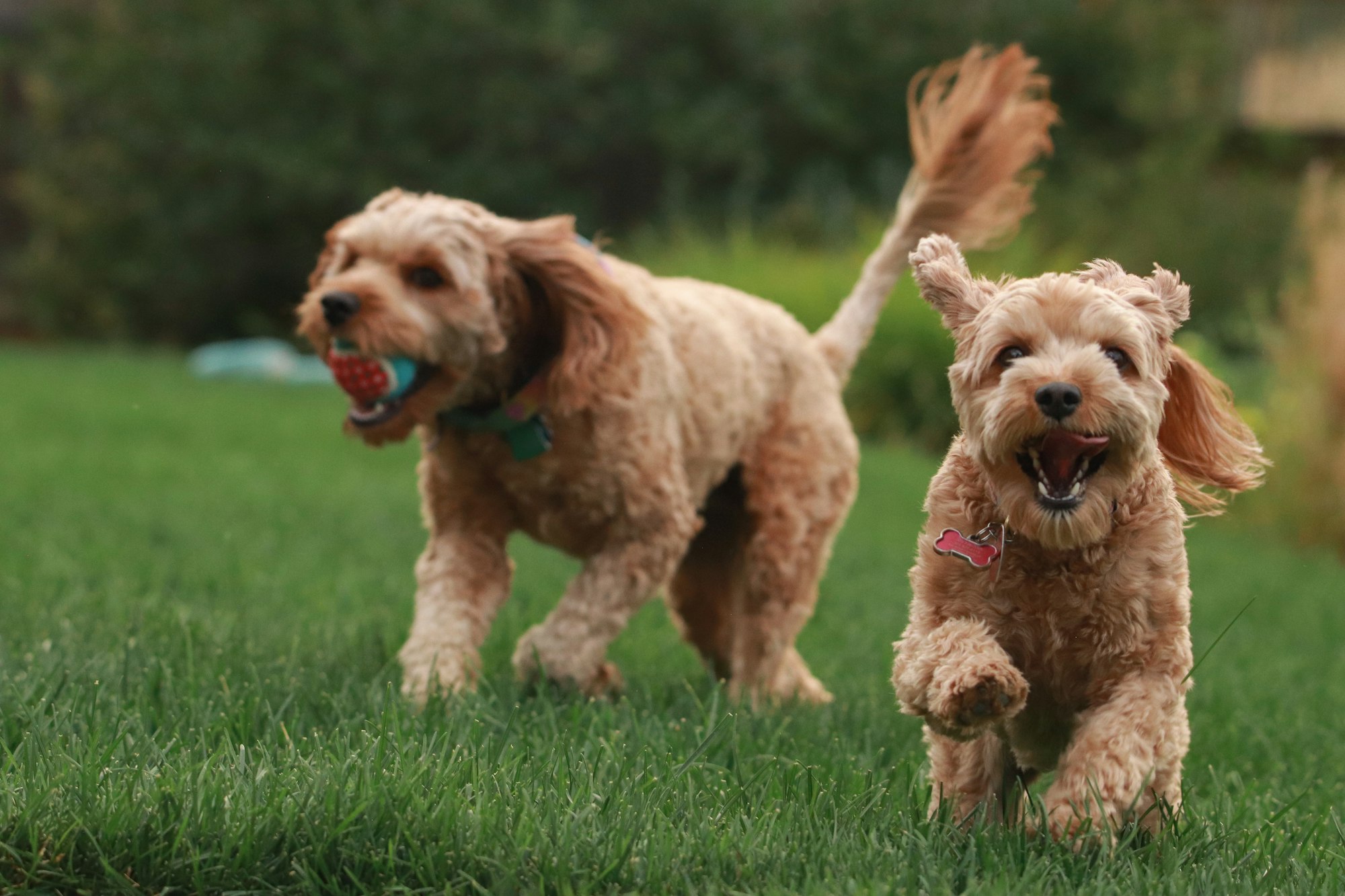Playtime with your canine companion, Max, is undoubtedly one of the highlights of both your days. But as the time flies by, a question lingers in your mind, "How long should this playtime last? Am I providing enough exercise, or perhaps too much?" This age-old conundrum resonates with many pet owners. So, let's untangle the mystery behind the ideal playtime for our beloved dogs with some expert advice.

Unraveling the Significance of Dog Playtime
At its core, playtime transcends mere physical activity. It's a cocktail of mental engagement, emotional bonding, and a platform to impart essential social cues. Every canine, from the petite Pomeranian to the majestic Mastiff, craves and benefits from play. But determining the perfect duration? That’s the golden question.
The Crucial Factors That Influence Playtime
Dog’s Age: The Pups vs. The Elders
The sprightly energy of puppies is infectious! These little furballs are bustling hubs of curiosity and playfulness. However, their stamina isn’t as enduring. For puppies, short, multiple bursts of play are more appropriate. On the flip side, our graceful senior dogs, with their years of wisdom, might not have the same zest but still cherish their play moments, albeit shorter and gentler ones.
The Breed and Size Equation
It’s no secret that a Siberian Husky or an Australian Shepherd is a powerhouse of energy, demanding extended play sessions compared to the more sedate Basset Hound. Generally, larger breeds tend to house more vigor, but remember, every dog is an individual, and stereotypes don’t always fit.
Navigating Health and Physical Ailments
Just as with humans, dogs with health concerns or physical impediments need tailored play routines. It's not just about the quantity but the quality of play. Always let your veterinarian be your guiding star in these matters.
Expert Recommendations on Playtime Duration
An average adult dog thrives on two bouts of energetic play, each spanning 15-20 minutes daily. Yet, flexibility is crucial. Some dogs are satiated with a consolidated 30-minute session, while others prefer frequent, spirited stints throughout their day.
Red Flags: The Dangers of Overindulgence
There’s a fine line between rigorous play and overexertion. To maintain that balance, be watchful for:
- Labored breathing or persistent panting.
- Any signs of limping or discomfort post-play.
- A sudden dip in enthusiasm for their favorite game.
- Tiredness that lingers longer than usual.
Safety first! Their well-being is always the priority.
Crafting the Perfect Playtime Blueprint
- Diversity is Key: Don't be monotonous. Rotate between fetch, tug-of-war, or even brain games. It’s about creating a balanced blend of physical and cognitive challenges.
- Toy Time: Toys aren’t mere distractions. They can amplify the fun quotient and can be instrumental in learning new tricks.
- Be Observant: Your dog’s behavior is the best feedback mechanism. Adapt playtime based on their cues.
- Safety Check: An environment free from potential hazards is non-negotiable. This includes sharp objects, harmful substances, or potential choking hazards.
The Emotional Benefits of Play
Beyond the physical realm, the act of playing with your dog touches deeper emotional chords. It's not just about tossing a ball or playing tug-of-war; it's about connecting, understanding, and building trust. Your dog perceives these moments as more than just a game. For them, it's quality time with their favorite human.
Building Trust and Deepening Bonds
Every moment spent playing with your dog fortifies the bond between the two of you. It instills a sense of trust and reassurance. Dogs, inherently social animals, view play as a form of affection and bonding. This emotional connection is vital, especially for rescued or adopted dogs that might have had a difficult past. Playtime aids in bridging the gaps of mistrust and apprehension.
Boosting Mental Health
Just as humans can feel the blues, dogs too can face periods of anxiety, stress, or even depression. Consistent play routines serve as therapeutic sessions for them, offering an outlet for pent-up emotions and energies. It's a form of escapism, a break from any internal turmoil they might be experiencing.
Training and Learning Opportunities
Ever tried teaching a new trick during play? If not, you’re missing out! Dogs are often more receptive to learning when it's integrated into their play sessions. It becomes less of a 'task' and more of a 'game' for them. This playful learning approach can be especially effective for stubborn or easily distracted breeds.
Tips for Enriching Playtime
- Change the Scenery: If you always play in your backyard, consider taking your dog to a nearby park or a different environment. New scents and sights can make play more stimulating for them.
- Introduce New Toys Periodically: Just as kids can get bored with the same old toys, so can dogs. Introducing a new toy can reignite their interest in play.
- Engage in Group Play: Sometimes, letting your dog play with other dogs under supervision can offer a different kind of stimulation and social interaction. It helps improve their social skills and gives them a break from the routine.
Tailoring Playtime: Every Dog is Unique
While guidelines and expert advice provide a roadmap, every dog carries their unique personality, preferences, and needs. Understanding these intricacies is essential to tailor playtime sessions that align with their character.
Understanding Play Preferences
Some dogs might love the thrill of chasing, while others might find solace in puzzle toys. Observing what excites your dog the most can help craft more engaging play sessions. For instance, a Beagle might relish scent-based games, given their strong olfactory abilities, while a Greyhound might find immense joy in short sprinting sessions.
Incorporating Daily Routines
Integrate playtime into your daily routines. Morning stretches can be accompanied by a short fetch session, or evening relaxation can include gentle tug-of-war. Such integration ensures your dog gets consistent play without it feeling like a chore for you.
Weather and Environment Adaptations
Weather can greatly influence play. On scorching days, consider water-based play activities like splash pools or sprinklers to keep your dog cool. Conversely, on colder days, indoor obstacle courses or hide-and-seek sessions can be thrilling.
Recognizing the Non-Verbal Cues
Dogs communicate volumes through their body language. A wagging tail, perked up ears, or a playful bow are direct invitations for play. On the flip side, a tucked tail, avoidance, or yawning might indicate they need rest or aren't interested. Being attuned to these cues can make playtime more efficient and enjoyable for both parties.
The Joy of Post-Play Rituals
Concluding playtime with a ritual can be both comforting and beneficial. Whether it's a short grooming session, a treat, or simple cuddling, post-play rituals signify to your dog that playtime is over and it's time to relax. This helps especially if you want to establish a routine or wind down high energy levels before bedtime.
The Evolution of Play: Adapting to Life's Changes
Life is a dynamic journey with its twists and turns, and as time goes on, our relationships with our pets inevitably evolve. The playful puppy days transition to the mature calm of the adult years and eventually to the gentle pace of the golden years. Here's how you can navigate and adapt playtime through these stages of your dog's life.
The Learning Curve of Puppies
With boundless energy, everything is a game for puppies. But this is also a critical phase for instilling good behavior and boundaries. Use playtime as a means of education. Basic commands like 'sit', 'stay', and 'fetch' can be seamlessly integrated into games, making learning fun and effective.
The Consistency of Adult Years
As your dog matures, their energy levels might stabilize, but their need for engagement remains. This is the phase to solidify routines, introduce more complex games, and even dabble in agility or obedience training. It's also the time when any health concerns or specific breed-related needs become apparent. Always adapt playtime considering these factors.
Cherishing the Senior Moments
Golden years bring with them a sense of calm, but also certain limitations. Arthritis, vision problems, or reduced stamina might come into play. But this doesn't mean playtime should be shelved. Instead, opt for gentler games. Soft toys, slow-paced walks, or simple scent games can be both engaging and comfortable for senior dogs.
The Role of Technology in Modern Play
In today's digital age, there's a slew of gadgets and tech tailored for pets. From interactive toys that move on their own to puzzle feeders that challenge your dog's intellect, technology has revolutionized play. While traditional games remain evergreen, occasionally introducing tech-based play can add a fresh twist.
Human and Dog: Partners in Play
Lastly, remember that playtime isn’t just beneficial for your dog; it's therapeutic for you too. It's a break from daily stresses, an exercise routine, and a chance for pure, unadulterated joy. Watching your dog's excitement, hearing their barks of glee, and feeling their happy nuzzles post-play can be the highlight of your day.
Play Beyond Boundaries: The Universal Language
Across cultures, countries, and continents, one thing remains constant in the relationship between humans and dogs: the language of play. It's a testament to the universal bond that exists between our species.
Cultural Interpretations of Play
In the snow-laden regions of Siberia, you'll find Huskies playing tug with their owners using sturdy ropes, channeling their inherent strength and endurance. Meanwhile, in the bustling streets of Tokyo, a Shiba Inu might be engaging in a quick game of fetch in one of the city’s compact parks.
Different cultures have unique play rituals, toys, and traditions, but the underlying essence remains consistent — an expression of joy, companionship, and mutual respect.
Healing Through Play: Therapy Dogs
Beyond casual play, the structured engagement between dogs and humans has been harnessed for therapeutic purposes. Be it in hospitals, schools, or rehabilitation centers, therapy dogs are introduced to play-based activities to provide comfort, reduce anxiety, and assist in various forms of therapy. Here, play becomes more than fun; it becomes a tool for healing, both physically and emotionally.
Global Dog Play Events
All over the world, events like dog agility competitions, frisbee tournaments, and canine carnivals celebrate the spirit of play. These events not only showcase the skills and bond between the dog and the owner but also underline the universal appreciation of play in the canine-human relationship.

Playtime Etiquette: Social Considerations
When engaging in public spaces, it's essential to be aware of playtime etiquette. Always respect boundaries — not all dogs (or people) might be comfortable with your dog's playful advances. Teach your canine pal to play without being overly aggressive and always clean up after them.
The Future of Play: Innovations on the Horizon
As our understanding of dogs deepens, so does the evolution of play. Research is continually uncovering new ways to stimulate our pets, both mentally and physically. Innovations like virtual reality dog games, AI-powered toys, and sensory enrichment tools are paving the way for a future where play becomes even more diversified and tailored to individual dog needs.
Conclusion:
In the heartwarming journey of dog ownership, playtime stands as a vital pillar of joy and connection. The question of "how long should you play with your dog?" finds its answer in understanding, adaptability, and the timeless bond between you and your furry friend. Tailor play to your dog's age, preferences, and energy levels. Blend training with play for an enriching experience. Prioritize safety and remember that every dog is unique. Seek professional guidance when needed. Ultimately, cherish every playful moment, for it's not about the clock but the laughter, the love, and the enduring magic of human-canine companionship. Enjoy the symphony of your shared adventures, where every wagging tail is a note of pure delight.
FAQs
- How long should I play with my dog each day?
- The ideal playtime duration varies depending on your dog's age, breed, and energy level. Generally, it ranges from 30 minutes to 2 hours per day, broken into multiple sessions.
- What are some indoor play activities for my dog?
- Indoor play can include games like hide-and-seek, gentle tug-of-war, puzzle toys, and basic obedience training. Be creative to keep your dog mentally and physically engaged.
- How can I ensure my dog's safety during playtime?
- Keep a close eye on your dog to prevent accidents. Inspect toys regularly for wear and tear, and make sure the play environment is free of hazards or toxic substances.
- Is it possible to over-exercise my dog during playtime?
- Yes, over-exercising can lead to fatigue and potential health issues. Pay attention to your dog's cues and avoid strenuous play, especially for puppies and senior dogs.
- Should I incorporate training into play with my dog?
- Yes, integrating training commands and rewards into play can be highly effective. It not only makes playtime more engaging but also reinforces positive behaviors.
- What should I do if my dog doesn't seem interested in playtime?
- Dogs can have varying moods. If your dog isn't interested in play, respect their wishes, and try again later. It's essential to understand and accommodate their preferences.






